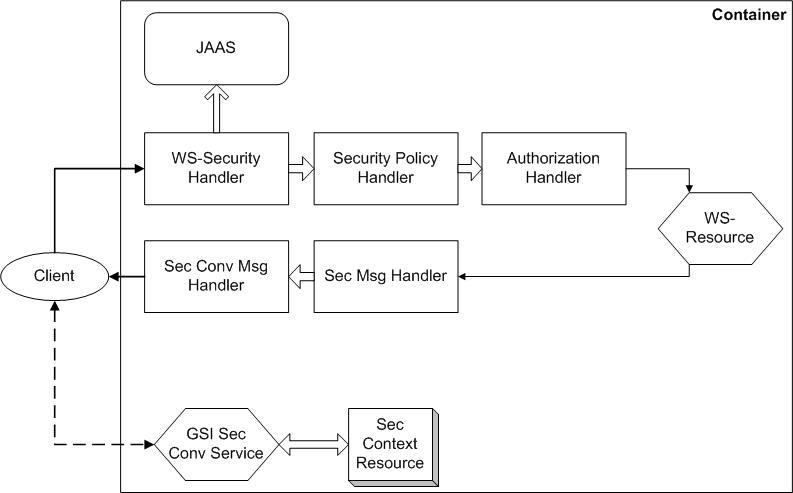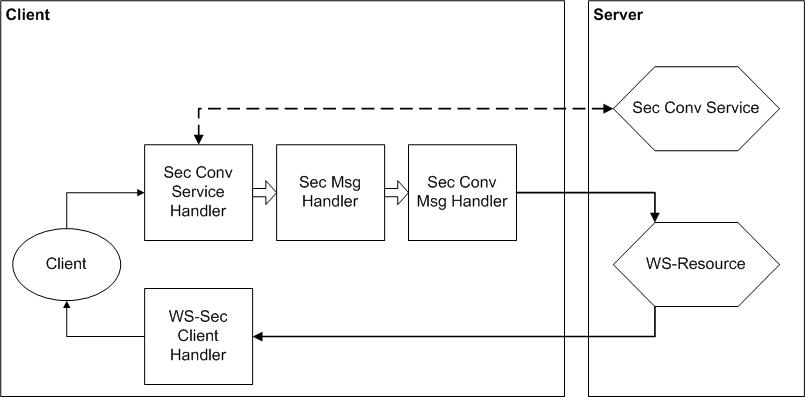Table of Contents
This component contains mainly framework level code and as such developing services and clients utilizing this component does in general involve either programmatically or declaratively driving the framework level security code. Now, what does this entail? On the programmatic side of things it involves acquiring credentials, passing these credentials on to the framework and setting various authentication and protection related flags, either in a descriptor or as properties on a stub object. On the declarative side it involves setting up security descriptors, both client and service side, to prescribe the security policy used to drive the security framework code.
Features new in GT 4.0
- Compliance with published IBM/Microsoft WS-Trust and WS-SecureConversation specifications
- Compliance with the Web Services Security 1.0 standard
- HTTPS support
Other Supported Features
- Message encryption, integrity protection and replay attack prevention
- Establishment of a session key for light-weight message protection
Deprecated Features
- GT 3.2 SecureConversation protocol
WS Authentication and Authorization Message & Transport Level Security should work on any platform that supports J2SE 1.3.1 or higher.
Tested Platforms for WS Authentication and Authorization Message & Transport Level Security
- Linux (Red Hat 7.3)
- Windows 2000
- Solaris 9
Protocol changes in WS Authentication and Authorization Message-Level Security since GT 3.2
- WS-SecureConversation updated to reflect published IBM/Microsoft specification.
- Web Services Security updated to reflect published OASIS standard (1.0).
API changes since GT 3.2
- N/A
Exception changes since GT 3.2
- N/A
Schema changes since GT 3.2
- N/A
WS Authentication and Authorization Message & Transport Level Security depends on the following GT components:
- The C implementation depends on C WS Core.
- The Java implementation depends on Java WS Core.
WS Authentication and Authorization Message & Transport Level Security depends on the following 3rd party software:
- Apache WSFX Security Libraries
- PureTLS Libraries
- BouncyCastle JCE provider
- Cryptix Libraries
- Apache XML Security Libraries
The toolkit by default is deployed with our implementation of transport security, which is based on HTTP over SSL, also known as HTTPS, with modifications to path validation to enable X.509 Proxy Certificate support. In contrast to the GT3 version of the toolkit, the default transport security enabled in the toolkit does not support delegation of proxy certificates as part of the security handshake.
However the underlying security libraries and handlers required for secure transport with delegation, also known as HTTPG, is still supported and shipped as a part of the CoG library. The GT4 Java WS code base and configuration can be modified to use the HTTPG protocol is required.
Transport security is implemented by layering on top of the GSISocket class provided in JGlobus. This class deals with the security related aspects of connection establishment as well as message protection. The socket interface serves as a abstraction layer that allows the HTTP protocol handling code to be unaware of the underlying security properties of the connection.
Container-level credentials are required and, irrespective of security settings on the service being accessed, these credentials are used for handshake.
On the server side transport security is enabled by simply switching a non-secure socket implementation with the GSISocket implementation. In addition to this change some code was added to propagate authentication information and message protection settings to the relevant security handlers, in particular the authorization and security policy handlers.
On the client side transport security is similarly enabled by switching a non-secure socket implementation with the GSISocket implementation and registering a protocol handler for HTTPS that uses the secure socket implementation. In practice this means that any messages targeted at a HTTPS endpoint will, irregardless of any stub properties, be authenticated and protected. It also means that any messages sent to a HTTP endpoint will not be secured, again irregardless of any stub properties. Stub properties are only used to communicate the desired message protection level, i.e. either integrity only or integrity and privacy.
This section aims to describe the message flow and processing that occurs for a security-enabled service. The figure below shows the JAX-RPC handlers that are involved in security related message processing on a server.

GT4 provides two mechanisms, GSI Secure Conversation and GSI Secure Message security, for authentication and secure communication.
In the GSI Secure Conversation approach the client establishes a context with the server before sending any data. This context serves to authenticate the client identity to the server and to establish a shared secret using a collocated GSI Secure Conversation Service. Once the context establishment is complete the client can securely invoke an operation on the service by signing or encrypting outgoing messages using the shared secret captured in the context.
The GSI Secure Message approach differs in that no context is established before invoking an operation. The client simply uses existing keying material, such as an X509 end entity certificate, to secure messages and authenticate itself to the service.
Securing of messages in the GSI Secure Conversation approach, i.e. using a shared secret, requires less computational effort than using existing keying material in the GSI Secure Message approach. This allows the client to trade off the extra step of establishing a context to enable more computationally efficient messages protection once that context has been established.
When a message arrives from the client the SOAP engine invokes several security related handlers.
The first of these handlers, the WS-Security handler, searches the message for any WS-Security headers. From these headers it extracts any keying material, which can be either in the form of an X509 certificate and associated certificate chain or a reference to a previously established secure conversation session. It also checks any signatures and/or decrypts elements in the SOAP body. The handler then populates a peer JAAS subject object with principals and any associated keying material whose veracity was ascertained during the signature checking or decryption step.
The next handler that gets invoked, the security policy handler, checks that incoming messages fulfill any security requirements the service may have. These requirements are specified, on a per-operation basis, as part of a security descriptor during service deployment. The security policy handler will also identify the correct JAAS subject to associate with the current thread of execution. Generally this means choosing between the peer subject populated by the WS-Security handler, the subject associated with the hosting environment and the subject associated with the service itself. The actual association is done by the pivot handler, a non-security handler not shown in the figure that handles the details of delivering the message to the service.
The security policy handler is followed by an authorization handler. This handler verifies that the principal established by the WS-Security handler is authorized to invoke the service. The type of authorization that is performed is specified as part of a deployment descriptor. More information can be found in there authorization framework documentation.
Once the message has passed the authorization handler it is finally handed off to the actual service for processing (discounting any non security related handlers, which are outside the scope of this document). Replies from the service back to the client are processed by two outbound handlers: the GSI Secure Conversation message handler and the GSI Secure Message handler. The GSI Secure Conversation message handler deals with encrypting and signing messages using a previously established security context, whereas the GSI Secure Message handler deals with messages by signing or encrypting the messages using X509 certificates. The operations that are actually performed depend on the message properties associated with the message by the inbound handlers, i.e. outbound messages will have the same security attributes as inbound messages. That being said, a service has the option of modifying the message properties if so desired. These handlers are identical to the client side handlers described in the following section.
This section describes the security related message processing for Java-based GT4 clients. In contrast to the server side, where security is specified via deployment descriptors, client side security configuration is handled by the application. This means that a client side application has to explicitly pass information to the client side handlers on what type of security to use. This is also true for the case of services acting as clients. The below figure shows the JAX-RPC handlers that are involved in security related message processing on a server.

The client side application can specify the use of either the GSI Secure Conversation security approach or the GSI Secure Message security approach. It does this by setting a per message property that is processed by the client side security handlers.
There are three outbound client side security handlers:
The secure conversation service handler is only operational if GSI Secure Conversation mode is in use. It establishes a security session with a secure conversation service collocated with the service with which the client aims to communicate. When the client sends the initial message to the service with a property indicating that session based security is required, this handler intercepts the message and establishes a security session. It will also authorize the service by comparing the service's principal/subject obtained during session establishment with a value provided by the client application. Once the session has been established the handler passes on the original message for further processing.
The next handler in the chain, the secure message handler, is only operational if GSI Secure Message mode is in use. It signs and/or encrypts messages using X.509 credentials.
The third outbound handler is operational only if GSI Secure Conversation mode is in use. It handles signing and/or encryption of messages using a security session established by the first handler.
The client side inbound handler (the WS-Security client handler) deals with verifying and decrypting any signed and/or encrypted incoming messages. In the case of GSI Secure Message operation it will also authorize the remote side in a similar fashion to the outbound secure conversation service handler.
The semantics and syntax of the APIs and WSDL for the component, along with descriptions of domain-specific structured interface data, can be found in the public interface guide.
There are two ways a client can delegate its credential to a service: a) using Delegation Service b) using GSI Secure Conversation.
Client can delegate using the Delegation Service. This method is independent of the security scheme used and can be reused across multiple invocations of the client to multiple services (provided the service are in the same hosting envorinment as the delegation service). The link provided has details on client side steps to delegate and service side code to get the delegated credential.
GSI Secure Conversation has delegation built into the protocol. Delegation can be requested by setting the GSIConstants.GSI_MODE property on ther Stub or using security descriptors as described here. If full or limited delegation is performed, the client credential can be obtained from the message context as follows:
Subject subject = (Subject) msgCtx.getProperty(Constants.PEER_SUBJECT);
The server can be configured such that container, service or client credentials are used for the operation invoked. For the client credentials to be used, client should have delegated the credentials. Configuring this option is described here. Note that this is a server side configuration. If caller-identity is chosen for the run-as configuration and the client's credentials have been successfully delegated, then the delegated credentials are associated with the current thread. The credentials in this case can be obtained as follows:
Subject subject = JaasSubject.getCurrentSubject();
See Section 7, “Associated standards” for a list of associated standards.
